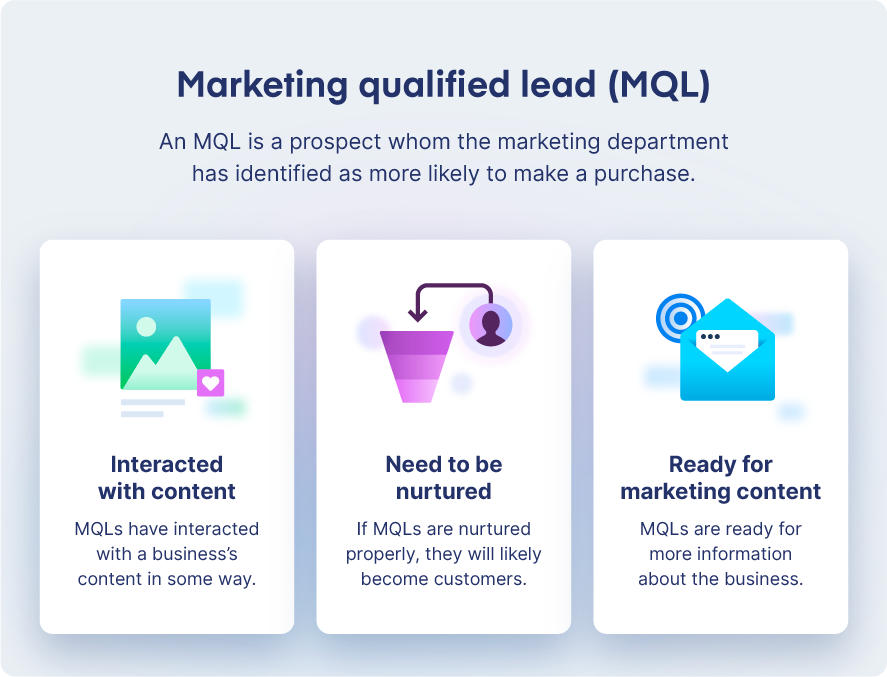The ultimate guide to marketing qualified leads (MQLs)
Tired of wasting time and resources on leads that don’t convert? If so, then it’s time to get serious about marketing qualified leads.
Marketing qualified leads (MQLs) are prospects who have been identified as more likely to make a purchase than other prospects. These individuals have interacted with your business in some way, such as signing up for a webinar or requesting a product demo. When nurtured properly, MQLs have real potential to turn into paying customers.
But that’s the problem: nurturing MQLs properly. The criteria for defining MQLs and the next steps to take can get muddled between marketing and sales, leading to a breakdown in interdepartmental communication and missed opportunities for new business.
In this guide, we’ll detail everything about MQLs—from qualification criteria and aligning marketing and sales to how marketing tools like we offer at Clearbit can aid in gathering critical consumer information.
What is a marketing qualified lead?
A marketing qualified lead is a prospect whom the marketing department has identified as more likely to make a purchase. These consumers show fit and behavioral intent by interacting with the brand’s content in some way, such as visiting the website multiple times, submitting contact information, or anything else an organization deems relevant.
MQLs are important for a business because they have started to move down the sales funnel and have a better chance of becoming customers.
That said, it’s important to note that this concept requires alignment from both marketing and sales to determine what specific actions qualify a prospect as an MQL—passing a prospect to sales too early or too late in the buyer journey can mean a missed opportunity for new business.

MQLs represent a lead at the very beginning of the buyer’s journey. As your business continues to nurture and interact with these prospects, they will continue to move through the buyer’s journey until they become a paying customer. The full journey looks something like this:
Awareness: At this stage, a consumer is aware they have a problem and will start to look for a solution to their problem. This stage is where you’ll find MQLs as they start to interact with your content.
Consideration: At this stage, the lead is considering purchasing a solution to their problem. In this stage, you’ll find sales qualified leads or SQLs as they start interacting with sales. We will cover SQLs in-depth later in this post.
Decision: In the decision stage, the lead is close to making a purchase decision. The prospect will look at pricing and might test the software through a free trial. Leads who interact with your product through a free tool or trial are called Product Qualified Leads or PQLs. We have more information on the PQL framework here.
How to identify and qualify MQLs
The most important thing to consider when identifying marketing qualified leads is that there is no one-size-fits-all template. A consumer’s actions that label them as an MQL should be different from business to business, and decided upon by a collaborative effort between sales and marketing.
When identifying MQLs for the future, look at your historical customer trends. Are there common actions buyers have taken early in the sales funnel? Perhaps a large number of your eventual customers signed up for a free trial or submitted contact information for email updates. Past consumer data can serve as a guide for establishing MQL qualifications.
While the criteria is different for every business, here are a few common actions consumers could take to be labeled as an MQL:
- Visiting product pages: An organization can use intent data to see how consumers are interacting with their website. When paired with tools like Clearbit, to reveal which companies are on your site, it can help you identify warm leads and MQLs faster in the buying process.
- Registering for a webinar: Signing up for a webinar or other educational content clearly means a consumer is interested in more information. This could signal an MQL, and lead a business to optimize their educational content to convert more effectively.
- Consistent, positive interaction with social media posts: If a user is consistently interacting with a business’s social media posts—in a positive way, of course—this could be a good indicator of a potential marketing qualified lead. The business should then conduct more research to capture these interactions.
- Requesting a demo or free trial: Consumers who request a demo or sign up for a free trial are interested in how the product performs. Businesses should contact these individuals immediately, as they may even be beyond the MQL stage.
- Submitting contact forms: Any time a consumer willingly submits contact information to a business, they are likely interested in making a purchase. This can lead a marketing team to label them as a marketing qualified lead, and potentially even a higher-priority lead.
What is the difference between an MQL and an SQL?
Both marketing qualified leads and sales qualified leads (SQLs) refer to consumers in the sales funnel, but the difference lies in what specific stage they are in.
MQLs are individuals who have interacted with a business in some way—be it signing up for a newsletter, browsing the company website, signing up for a webinar, or anything else deemed relevant by the business. These consumers are labeled by the marketing department as more likely to buy, but are still in the consideration stage of the buyer journey.
SQLs are individuals who have transitioned into the decision stage of the buyer journey and are ready to be passed to the sales department. These prospects have shown a sustained interest in a business’s product or service, and have been properly vetted to ensure they have a high chance of converting.
There are a few different ways to qualify an SQL, but one of the most popular is with the BANT process:
- Budget: Can the prospect afford your offering? Furthermore, are they willing to pay for it?
- Authority: Who is the ultimate decision-maker, or authority figure in this transaction?
- Need: Is the prospect truly in need of your offering? Is this needed on a team-wide or individual scale?
- Timeline: How long will it take the prospect to make a purchasing decision?
Ultimately, prospects that pass the BANT criteria should be labeled as SQLs.

How do you get marketing qualified leads?
Establishing a system to identify and nurture MQLs is crucial to turn prospects into customers effectively. Here are a few steps a business can take to identify marketing qualified leads.
1. Ensure sales and marketing departments are aligned
From identifying a prospect as an MQL to turning them into a customer, sales and marketing departments should be aligned every step of the way.
Getting both departments under the same umbrella—or, at the very least, on the same page—is important for developing a unified framework for what an MQL looks like. After all, if the marketing department passes along a prospect to sales too early or too late, it can result in missed opportunities for new customers and revenue growth.
Sit down with both departments and look at historical consumer trends to determine what actions are most important in determining MQLs for your business. For example, maybe the majority of individuals who sign up for a webinar eventually end up purchasing your product or service—or maybe individuals who are passed to sales without first receiving an informational packet rarely convert to customers.
Aligning both departments is a key first step to determining the meaningful actions an individual could take to become an MQL, and how you can properly nurture them to become future customers.
2. Create personalized content for your ICP
The next step in the process is to define your ideal customer profile (ICP) and create personalized content for them.
An ICP is a description of a company that’s the perfect fit for your product or service. In other words, it’s a snapshot of what the ideal company would look like—and therefore, realize the most value—for your offering. This snapshot includes important variables such as industry, location, company size, business model, and unique pain points.
Once a comprehensive ICP has been established, you should personalize your content to ensure your message resonates with your ideal customer. There are many ways your business can personalize messaging, and here are five digital marketing touchpoints to start with:
- Website: Your website is ground zero for prospect interaction. Based on what they see when they first enter, they will either stay to learn more, or leave within a few seconds. Personalizing your site with tailored messaging, calls to action, social proof, and more can ensure prospects stick around.
- Chat: Chat functions are a great way to interact with visitors while they’re browsing your site, but to really optimize this process you need to know who your most valuable visitors are. Tools like Clearbit Reveal can integrate with other software to personalize your chat, and ensure you are contacting the most qualified prospects.
- Email: Between the subject line and text preview, you only have a few words to make an impression in your emails. Personalize the subject line and body content to increase open rates, and resonate with the recipients.
- Video: Nearly four in five people have been convinced to buy or download a product after watching a video. Experiment with video content around your website, emails, retargeting ads, and more to deliver unique messaging to your prospects.
- Ads: PPC advertising has the potential to reach thousands of qualified prospects—but only if you personalize it correctly. Tools like Clearbit Advertising can help your ad content reach the right audience, and resonate with them.
3. Revisit that definition periodically
Businesses grow, industries evolve, and consumer preferences change rapidly—that’s why it’s important for businesses to treat their MQL definition as ever-changing.
It’s a smart practice to have periodic meetings between sales and marketing to determine if the definition of a marketing qualified lead is still valid or if there are changes that should be made. These meetings can be monthly, quarterly, or bi-yearly; whatever you think is most prudent for your industry and customer base.
It’s important to remember that even if an MQL definition works now , without adaptation and evolution, it won’t guarantee future success.
Clearbit can supplement your MQL efforts
Marketing qualified leads are an important subset of consumers, and should be nurtured as effectively as possible to turn them into future customers. Doing so effectively takes a concrete understanding of your ideal customer profile, and a wide range of personalized content that resonates with them.
At Clearbit, we build products focused on helping you identify and capture marketing qualified leads, and keep them moving down the sales funnel.

